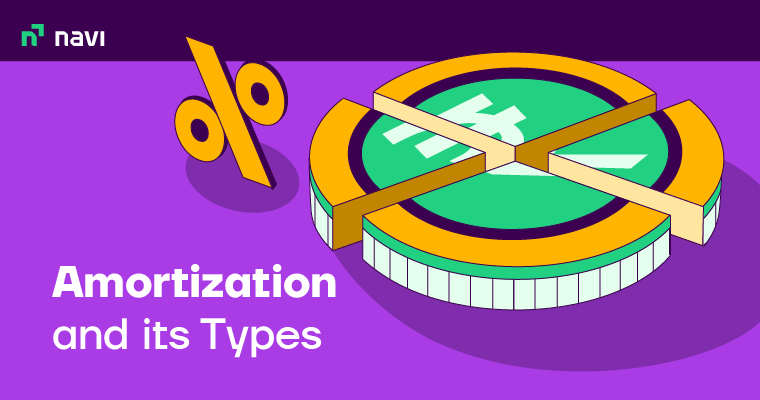What is Amortization – Working, Example, Formula and Calculation

Amortization refers to the process of reducing a debt with regular payments. If you have taken a loan or are planning to take one, you might want to read this article about amortization.
Read on to understand how amortization works, its types, how it’s calculated, and much more.
What is Amortization?
Amortization refers to spreading the loan amount into a series of fixed payments. Eventually, the loan is paid off when the amortization schedule ends. Furthermore, it’s about how the loan payment is applied to different types of loans. While the monthly payments you must make remain the same, your loan balance reduces by dividing the monthly payment among interest costs. The last payment you make shall pay off the final amount that remains on your debt.
How Does Amortization Work?
Here’s how amortization works in a few simple steps:
- A borrower takes out a loan from a lender.
- The borrower should begin making regular payments as part of the repayment process. During the early stages of the amortization curve, a significant portion of the cost goes towards repaying the interest instead of the principal amount.
- During the later stages of the amortizing curve, a substantial part of the borrower’s payment goes toward repaying the principal amount and less towards interest.
- The borrower will repay the loan once the accumulated interest and the entire principal amount have been compensated. However, refinancing a mortgage loan can restart the amortization curve.
What are the Types of Amortization?
The types of amortization can be classified based on their application areas, including real estate and business:
1. Real Estate
- Full Amortization: You pay the amortization amount, making the balance zero at the end of the term.
- Partial Amortization: Your monthly amount is reduced when you make a partial payment of the amortization amount. You will also have an outstanding balance at the end of your loan term.
- Interest Only: You only pay the interest without making payments towards the amortization amount. Thus, you will have the principal amount outstanding at the end of the term, as it was at the start.
- Negative Amortization: You make monthly payments lower than the interest rate. At the end of the term, you will have a larger amount than the principal amount.
2. Business
- Straight-line: It is also referred to as linear amortization. You distribute the interest amount equally throughout the loan amount. It’s a preferred accounting method, owing to its simplicity.
- Annuity: You pay equal amounts at equal intervals.
- Declining Balance: Each payment you make is more than the interest, and the balance amount of the loan gradually decreases.
- Bullet: You make regular payments that only include the interest amount. Eventually, you pay a big-ticket amount at the end of the tenure.
- Negative Amortization: It is similar to negative amortization for real estate.
How to Calculate Amortization?
a) Formula
Here’s the generally accepted formula for calculating amortization:
Principal Payment = TMP − (OLB × 12 Months / Interest Rate)
Where:
- TMP is the total monthly payment.
- OLB is the outstanding loan balance.
Total Payment = Loan Amount × [(1+i) n−1i×(1+i) n]
Where:
- i, is the monthly interest payment.
- n is the number of payments.
b) Calculation:
Here’s a step-by-step process to calculate amortization:
- Calculate the first month’s interest and principal amount.
- Gather all the information you need to calculate the amortization of the loan
- Calculate the interest on the monthly payment for one month.
- Calculate the principal amount for one month
- Use the new principal amount at the end of the first month to calculate amortization for the second month
- Determine the principal repayment for the second month
- Next, calculate the amortization for the entire term of the loan
To avoid the complicated mathematical calculation, you can also make use of any of the online loan amortization calculators
What is an Example of Amortization?
For example, you have a loan outstanding amounting to Rs.50,000. If you pay Rs. 10,000 of the principal yearly, Rs.10,000 of the loan amount has been amortized yearly. Furthermore, you should record Rs.10,000 in your books as an amortization expense each year.
What are the Benefits of Amortization?
Listed below are the primary benefits of amortization:
- Amortization has a comparatively low investment risk
- The repayment schedule is fixed
- The amortization table helps in evaluating multiple loan options
- You can calculate how much you would potentially save by paying off your debt early
Why Should You Opt for Amortization?
Consider paying back a loan without a repayment schedule. Making a one-time payment towards the final repayment of the loan could be practically impossible, considering the huge amount of principal and interest, especially in loans like a home or a car.
Repayment of large sums of payments towards a loan can also set your personal and financial objectives back for years. You can better organise your finances by managing huge loan repayments with amortization. This repayment method also gives the management of your debt top priority.
Also Read
How to use the Amortization Calculator?
With an amortization calculator, you can see how different loan options affect your monthly payments. Changing the inputs, including interest rate, loan term, and the amount borrowed, will let you know what your monthly payment will be, how much each payment will go toward principal and interest, and what will be your total interest obligation over the lifetime of the loan.
Any loan with fixed monthly payments and a defined end date can be calculated using the amortization calculator, regardless of whether it is a student loan, auto loan, or fixed-rate mortgage.
Final Word
The amortization process involves spreading out a debt over the loan tenure. Payments are made according to the amortization schedule until the loan is repaid in full. A portion of each payment goes toward interest costs and your loan balance.
The more you pay toward your balance, the less interest you will have to pay. You can also understand how your payments are applied with the help of an amortization table. Common examples of amortizing loans are car, home, and personal loans.
FAQs
Ans. Negative amortization occurs when the debt grows even when you pay on time. It happens due to the interest on the loan being higher than the amount of each payment.
Ans. Both amortization and depreciation attempt to capture the costs associated with holding an asset over time. However, the primary difference between them is that amortization refers to intangible assets, while depreciation refers to tangible assets.
Ans. The loan amortization schedule can be used to calculate the amortization rate. In an amortization schedule, the percentage of interest payments decreases slightly with each amount; however, the percentage of principal payments increases.
Ans. Over the lifetime of a fixed asset, such as a computer or car, amortization expenses are incurred. When an amortization expense appears on the income statement, the intangible asset’s value is reduced by the same amount. It continues until the asset is either sold or substituted.
Ans. Amortization can only be applied to intangible assets.
Disclaimer
This article is solely for educational purposes. Navi doesn't take any responsibility for the information or claims made in the blog.

Customer’s Feedback
No comments found.HSBC Bank Home Loan Interest Rate April 2023
HSBC offers a variety of home loan products designed for Indian citizens and NRIs (Non-Resident Ind... Read More »Axis Bank Home Loan Interest Rate April 2023
Axis Bank home loan interest rate starts at 8.75% p.a. The bank offers home loans up to ₹5 crore ... Read More »Karnataka Bank Home Loan Interest Rate April 2023
Karnataka Bank home loan interest rate starts at 9.26% p.a. The bank offers an array of home loan s... Read More »BBMP Property Tax – How to Calculate, Check Status and Pay Tax?
The Karnataka State Government imposes this tax on the residents of the State who own properties in... Read More »Union Bank of India Home Loan Interest Rate April 2023
Union Bank of India offers up to 90% of the property value as home loan. Union Bank home loan inter... Read More »Hartalika Teej in India 2023 – Muhurat and Rituals (18th Sept)
Hartalika Teej is an auspicious festival for Hindu women. The day is mainly dedicated to Goddess Pa... Read More »Bank of Baroda Home Loan Interest Rate April 2023
Bank of Baroda (BoB) home loan interest rate starts at 9.15% p.a. For the salaried and 9.25% ... Read More »Stamp Duty in Thane 2023 – Property Registration Charges
In India, every State government levies a stamp duty on property transfers. The location, type of p... Read More »Stamp Duty in Karnataka 2023 – Property Registration Charges
If you have recently purchased a property in Karnataka, you are liable to pay stamp duty in Karnata... Read More »Stamp Duty and Property Registration Charges in Telangana
The state government in India is in charge of defining rules and standards and managing the collect... Read More »Stamp Duty and Property Registration Charges in Pune
Stamp duty and registration charges need to be paid to the state government to register your proper... Read More »Apply for EC Online in Karnataka 2023 – Fees and Charges
The Government of Karnataka has introduced an online service portal (the Kaveri Online Services por... Read More »Top 10 Chit Fund Schemes in India in 2023
Chit funds are one of the most popular return-generating saving schemes in India. It is a financial... Read More »10 Best Gold ETFs in India to Invest in April 2023
Gold ETFs or Gold Exchange Traded Funds are passively managed funds that track the price of physica... Read More »10 Best Demat Accounts in India for Beginners in 2023
Creation of Demat accounts revolutionised the way trades were conducted at the stock exchanges. It... Read More »20 Best Index Funds to Invest in India in April 2023
What is an Index Fund? An index fund is a type of mutual fund or exchange-traded fund (ETF) that... Read More »Best Arbitrage Mutual Funds to Invest in India in April 2023
Arbitrage funds are hybrid mutual fund schemes that aim to make low-risk profits by buying and sell... Read More »10 Best SIP Plans in India to Invest in April 2023
What is SIP? SIP or Systematic Investment Plan is a method of investing a fixed amount in ... Read More »10 Best Corporate Bond Funds in India to Invest in April 2023
Corporate bond funds are debt funds that invest at least 80% of the investment corpus in companies ... Read More »10 Best Bank for Savings Account in India [Highest Interest Rate 2023]
Savings account is a type of financial instrument offered by several banks. It lets you safely depo... Read More »
































